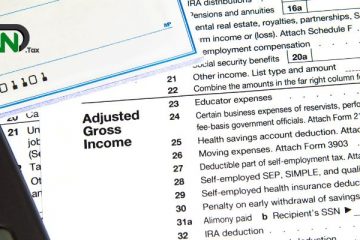College costs have gone sky-high, and parents are worried about sending their kids to college. They’re searching for any help they can get to cover tuition and other expenses. That’s where the American Opportunity tax credit (AOTC) comes in handy.
The AOTC can lower your tax bill by as much as $2,500 for each student per year. But like with anything tax-related, there are rules and twists you need to know. If you get how it works, the AOTC can help with education expenses for a student who qualifies.
Who gets this tax credit? Well, if you’re paying for the first four years of higher education for yourself, your spouse, or someone you’re taking care of, you might be eligible.
Now, there’s a catch. If you make too much money, you can’t use the full credit. The credit starts going down if your income is over $80,000 (if you’re single) or $160,000 (if you’re married). And if you earn more than $90,000 (if you’re single) or $180,000 (if you’re married), the credit is off the table.
Note: If parents make too much but still pay for college, their kid might file taxes independently and get the credit. It's worth calculating to see what's smarter.
To get the credit, you need to keep some papers handy. You’ll need Form 1098-T, a paper from your school showing your tuition. You also want to track any extra course stuff you pay for. Just make sure the expenses aren’t already covered by things like scholarships or savings plans.
Important: No double-dipping. If you're already using something like a 529 savings plan to pay for college, you can't also use the AOTC.
To claim the AOTC, you’ll use Form 8863 and attach it to Form 1040 when you file your taxes.
Table of Content
Getting the American Opportunity Tax Credit
First things first, you need to be eligible to claim the AOTC or the lifetime learning credit (LLC). This means you or your dependent should have received Form 1098-T, known as the Tuition Statement, from a legit educational institution, whether in your country or abroad. Usually, schools send this form by January 31. It’s like your credit guide. You’ll spot an amount in box 1 showing what you got during the year. But hey, that might not be the exact amount you can claim. For details on the right amount, check Publication 970 PDF, Tax Benefits for Education.
Remember, check that Form 1098-T is right. If it’s not or you didn’t get it, talk to your school.
To claim the AOTC, you have to fill out Form 8863 PDF and attach it to your tax return.
Precautions to Follow
- Hold up before you claim the AOTC. Make sure you’re eligible and hold onto copies of all the papers you used to check if you qualify and figure out your credit amount.
- If the IRS checks your return and finds out you claimed AOTC wrongly and you can’t show the papers proving you were eligible, you’ll need to pay back the AOTC amount you got by mistake, plus interest.
- And there might be penalties too, like an accuracy or a fraud penalty. You might even get locked out of claiming the AOTC for two to ten years.
- If your AOTC claim was rejected before, you might need to fill out Form 8862PDF before claiming the credit in the future. Check out the info on “My AOTC was Disallowed Previously and Now I Want To Claim It” in Form 8862 for the full scoop.
TIN Talk
- You can’t claim the AOTC unless you, your spouse (if you’re filing together), and the student you’re claiming for have a valid TIN (Taxpayer Identification Number) by the due date of your return (extensions included).
- A TIN could be your Social Security number, an individual taxpayer identification number (ITIN), or an adoption taxpayer identification number (ATIN).
- You can’t claim the AOTC on a later original return or an amended return if the TIN is issued or applied for after the due date of your return (even with extensions).
- To make sure you get the AOTC benefits if you qualify, make sure you sort out your TIN on time.
Income Info
Okay, let’s talk about the green stuff. To claim the full credit, your modified adjusted gross income (MAGI) needs to be $80,000 or less (for married couples filing together, it’s $160,000 or less).
- If your MAGI is over $80,000 but less than $90,000 (for married couples, over $160,000 but less than $180,000), you can still get a smaller credit.
- But, if your MAGI goes over $90,000 ($180,000 for couples filing together), you can’t claim the credit.
- MAGI is like a special version of your adjusted gross income (AGI) on your tax return. If you’re a Form 1040 person, add stuff like foreign earned income exclusion, foreign housing exclusion, foreign housing deduction, income exclusions for folks in places like American Samoa or Puerto Rico to your AGI to get your MAGI. If you need help, Publication 970PDF has worksheets to make it clearer.
Who’s Eligible for AOTC
To nab the AOTC, a student needs to meet these conditions:
- They’re studying for a degree or a recognized education qualification.
- They’re enrolled at least part-time for one academic period during the tax year.
- They haven’t completed their first four years of higher education at the start of the tax year.
- They haven’t claimed the AOTC (or the old Hope credit) for more than four tax years.
- They don’t have a felony drug conviction by the end of the tax year.
Expenses That Qualify
For AOTC, qualified education expenses include tuition and some related costs required for going to a legit educational place. These places can be public, nonprofit, or private colleges, universities, vocational schools, or other postsecondary educational spots.
What Doesn’t Count as a Qualified Education Expense?
Okay, here’s the scoop on what doesn’t make the cut for the AOTC. You can’t use it for things like room and board, getting around (like transportation costs), insurance, medical stuff (even those pesky student health fees), day-to-day living costs, and other personal expenses.
Now, when it comes to classes, if they involve sports, games, or hobbies and aren’t part of your degree program, they’re a no-go for AOTC. Same goes for non-credit courses.
Note: you can’t double-dip. So, if you’re already deducting something as a business expense on Schedule C, or you’re using it for the Lifetime Learning credit, or you’re figuring out the tax-free part of your 529 plan or Coverdell ESA withdrawals, or you paid for it with tax-free educational help like scholarships or grants, you can’t also claim it for the AOTC.
Related Expenses Include
- Student activity fees you pay to the school when you enroll.
- Books, supplies, and gear you need for classes, even if you don’t buy them from the school.
Now, Here’s the AOTC vs. Lifetime Learning Credit (LLC):
LLC lets you claim up to 20% of the first $10,000 in qualifying expenses (which is $2,000). Unlike AOTC, LLC isn’t just for degree chasers or part-timers. It covers a wider bunch of students, like part-timers, full-timers, undergrads, grad students, and those into skill-building courses. But here’s the twist: LLC can’t get you a refund once your tax bill hits zero.
How to Claim AOTC?
To claim AOTC or LLC, you must have received Form 1098-T, which means the Tuition Statement, from your school. Schools usually send this by January 31st. It’s like your credit compass. Box 1 on the form shows the cash you got during the year. But remember, this might not be the exact amount you can claim.
Note: Always double-check Form 1098-T for accuracy. If it's wrong or you didn't get it, don't hesitate to contact your school.
Now, onto claiming the credit. Once you’re sure you qualify for the American Opportunity Tax Credit, here’s what you do:
- Step 1: Get your hands on that 1098-T Form. Your school should give you one by January 31st. This form is essential because it helps you figure out how much credit you can get. But remember, the amount in Box 1 might not be the same as what you can claim.
- Note: Always take a good look at your Form 1098-T to make sure all the info is spot on. If you spot errors or didn’t get the form, don’t hesitate to reach out to your school for help.
- Step 2: Claim your credit. Once you’ve confirmed that you’re eligible for the AOTC, the next move is to actually claim it. You do this by filling out IRS Form 8863 and sending it along with your tax return.
When you claim the AOTC, you’ll need to provide the name and address of your educational institution, the amount you paid in qualified expenses, and the student’s Social Security Number or Individual Taxpayer Identification Number.
Note: Keep all your documents related to educational expenses, like tuition statements and receipts, handy in case the IRS wants to see them as proof.
Conclusion
In conclusion, understanding the American Opportunity Tax Credit (AOTC) and its details can be a valuable tool in managing educational expenses. While you can’t claim both AOTC and the Lifetime Learning Credit for the same student in a single tax year, these credits can significantly reduce your tax burden, potentially resulting in a refund. It’s important to assess your eligibility carefully and keep thorough records of your expenses to ensure a smooth tax filing process. And remember, if you ever have questions or need assistance regarding these tax credits, don’t hesitate to reach out for help. Your financial well-being is important, and seeking guidance from experts can make navigating the tax code a lot simpler.
Frequently Asked Questions
Can I Claim Both AOTC and Lifetime Learning Credit?
Nope, you can’t snag both credits for the same student in one tax year. But hey, if you have different students who meet the requirements, you might be able to claim both for them.
Is AOTC Worth It?
Totally! If you’re eligible, the American Opportunity Tax Credit can really slash your tax bill. And if the credit is more than what you owe, you could even get a refund. It’s a smart way to cut down on educational expenses.
Can I Claim AOTC and Lifetime Learning Credit Together?
Yes, you can claim both AOTC and the Lifetime Learning Credit (LLC) on your tax return. Just remember, you can’t claim both for the same student or expenses in one tax year.
Can I Claim AOTC if I Have a Grant?
Yes, you can. But you have to subtract that grant amount from your qualified education expenses before you go claiming the credit. So, let’s say you had $5,000 in costs and got a $4,000 grant. In this case, you can claim $1,000 of qualified education expenses for AOTC.
The stuff that counts as grants for AOTC includes:
· The tax-free parts of scholarships and fellowships.
· Need-based education grants like Pell Grants.
· Help from your employer.
· Educational assistance for veterans.
· Any other tax-free cash you get for education (except gifts and stuff you inherit).
How is AOTC different from LLC?
Well, AOTC and LLC are both education tax credits, but they have their quirks. AOTC is cool because it covers expenses for things like books and supplies, even if you didn’t pay the school for them. It’s more flexible. Plus, with AOTC, you can claim it for four tax years. Meanwhile, LLC doesn’t have a limit on how many years you can claim it.
How does AOTC impact my taxes?
Here’s the deal: AOTC directly chops down your tax bill by the amount you qualify for, dollar for dollar. So, if you qualify for the full AOTC and you owe $2,000 in taxes, your tax bill becomes $500 after applying the credit. And if the AOTC is more than what you owe, up to 40 percent of it (up to $1,000) can come back to you as a refund. It’s like getting a little bonus.




